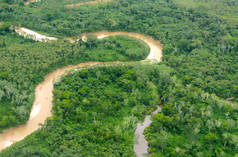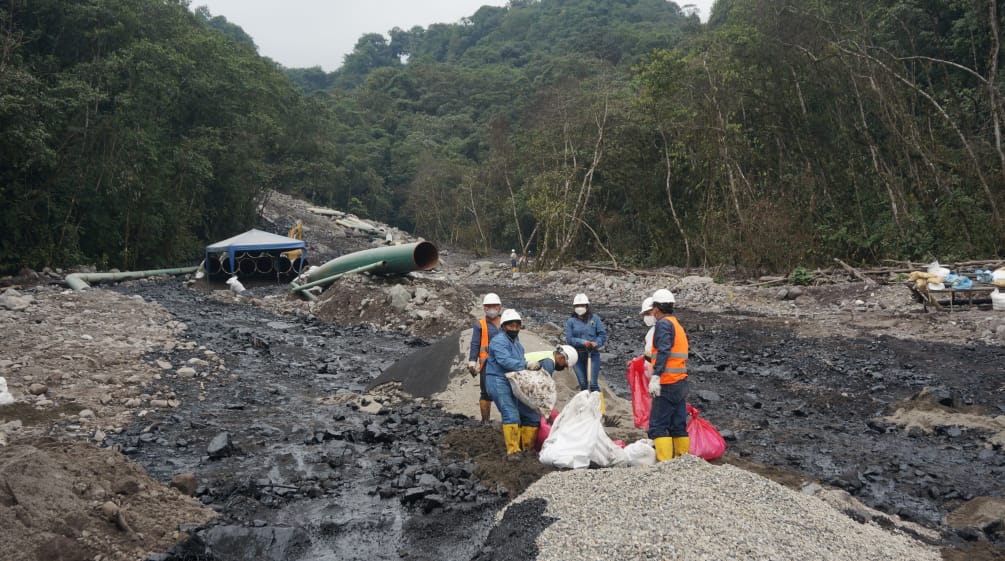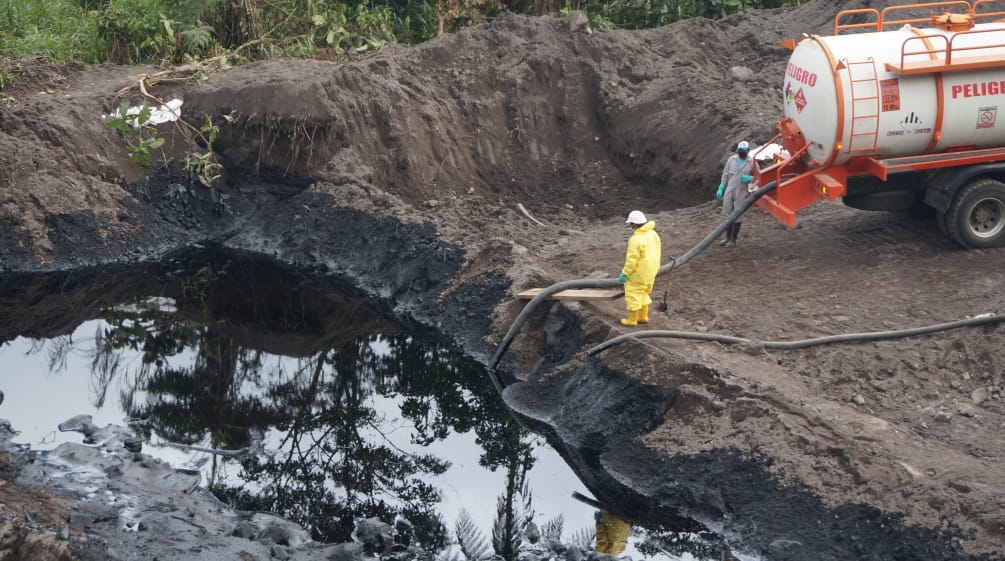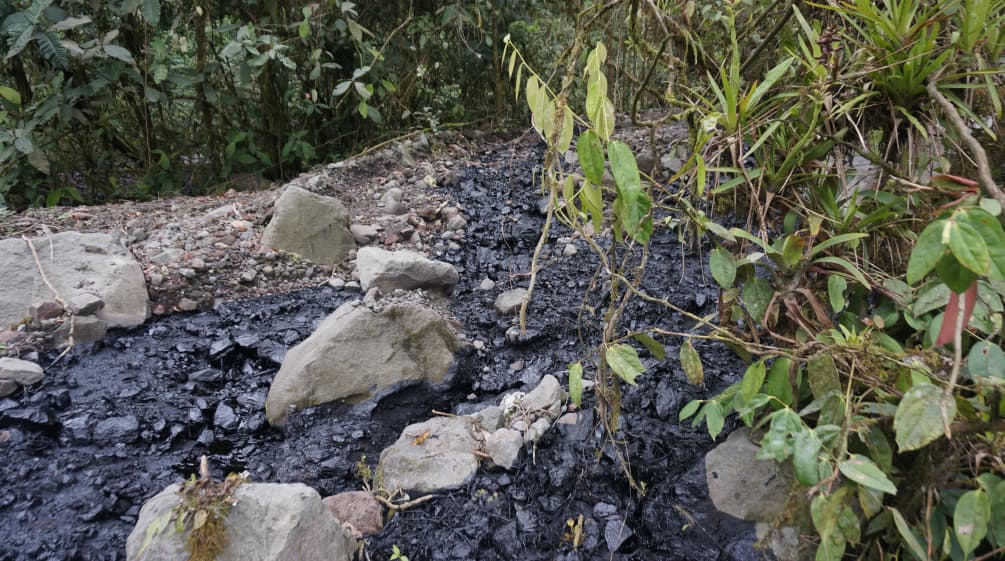Ecuador: Pipeline rupture causes oil spill in rainforest
Feb 1, 2022
The OCP heavy oil pipeline in Ecuador has ruptured again: According to the Minister of Energy, 6,000 barrels of crude oil have spilled in the rainforest. Indigenous inhabitants have complained about the rampant pollution of rivers in the Amazon region.
On Friday, January 28, 2022, a severe oil spill occurred in the Ecuadorian Amazon after another rupture of the OCP (Oleoducto de Crudos Pesados) heavy oil pipeline. The spill occurred on a mountain slope in the Piedra Fina sector on the edge of the Cayambe-Coca National Park.
Footage from the Teleamazonas television network shows the ruptured pipeline spouting oil into the rainforest, oil flowing between pipeline pipes down the mountainside and mixing with water from streams, which then flow into the Coca River down in the valley.
The indigenous associations CONAIE and CONFENIAE have documented the extent of the oil spill on Twitter with photos and videos under #SOSDerrameAmazonía. According to the reports, the oil is polluting dozens of kilometers of the Coca River as far as the Napo River, a tributary of the Amazon. Indigenous villages located along the rivers have been hit hard by the spreading oil.
According to Ecuadorian Energy Minister Juan Carlos Bermejo, 6,000 barrels of crude oil are believed to have leaked in the spill, writes El Comercio from Quito. The newspaper also reports another landslide on January 31, 2022, that would have hit the pipeline route nearby.
This is not the first such incident: In April 2020, the OCP pipeline along with two other oil pipelines collapsed into the Coca River a few kilometers away, causing a serious oil spill. 15,000 barrels of crude oil polluted downstream rivers in the Amazon.
Staff members of our partner organization Acción Ecológica from Quito and a journalist from the environmental news site Mongabay documented the situation on the ground. Piedra Fina is located at the foot of the El Reventador volcano, near the village of San Luís, in the municipality of Gonzalo Díaz de Pineda, in the province of Napo.
The witnesses report an unbearable stench of oil and sulfur. OCP is using excavators to create earthen basins and build dams to catch part of the spilled oil. From there, the oil is being pumped into tanker trucks for removal.
OCP and the Ecuadorian government downplay the situation
The operator OCP writes in a press release that the incident was "caused by falling rocks due to heavy rainfall". According to the statement, the company "is working at full speed to avoid any risk of oil reaching watercourses." On Saturday, moreover, "as a precautionary measure, the pumping operation of the pipeline was stopped to avoid environmental damage," OCP said in another release.
The Ecuadorian government and senior officials at the Ministry of the Environment downplayed the disaster on Twitter and Facebook. Government officials are ignoring the oil pollution in the rivers and are urging the pipeline to be reopened quickly so as not to affect oil production and exports.
Neither OCP nor the government is in control of the situation
A day before the spill, the Energy Ministry announced that the country's oil production was exceeding previous production volumes at 496,000 barrels a day, after suspending the country's oil exports "due to force majeure" on December 12, 2021. This was to allow work on "oil pipelines threatened by erosion in the Piedra Fina area". Two weeks before the OCP pipeline incident, on January 6, 2022, the government had lifted the measure.
For months, OCP has been carrying out construction work on the mountain slopes of the Coca River. OCP wrote in a press release in May 2021 that it was investing millions in the construction of a third route variant of the pipeline in the Piedra Fina area.
The state oil company Petroecuador also operates an oil pipeline and a fuel pipeline in the area. Both operators have now created several temporary and permanent route variants in the area and laid new oil pipelines, which have now been hit again by landslides.
The OCP pipeline is a product of ignorance and greed
The pipeline spills and their serious consequences do not come as a surprise: The 500-kilometer OCP pipeline runs through territory that is geologically extremely unstable. It is constantly threatened by severe earthquakes, volcanic eruptions, landslides and floods.
The OCP pipeline was built between 2001 and 2003 by a consortium of six international oil companies. At the time, Rainforest Rescue spoke out against the project together with Ecuadorian and international environmental and human rights organizations.
Even then it was clear: the OCP pipeline project would not be able to meet international environmental and social standards. The project has also prompted the development of further oil deposits in the Amazon region, such as in the world-famous Yasuní National Park, threatening the rainforest and the indigenous people living there.
Regression of the Coca River
In mid-December, Mongabay reported in detail on the completely out-of-control situation in Piedra Fina and large parts of the Coca River valley. The river has been in a process of rapid retrogressive erosion for the past two years: The water is eating its way deeper and deeper into the sediments and undermining the mountain slopes, which severely threatens the routes of the oil pipelines running there as well as an important highway from Quito to the Amazon lowlands. Houses and agricultural crops are also sliding into the abyss.
The rapid erosion is linked to the collapse of the San Rafael waterfall, located a few kilometers downstream, in 2020. There, at the foot of the El Reventador volcano, the river plunged spectacularly 150 meters over a former lava flow that had formed a barrier in the river bed after an eruption about 8,000 years ago. The river valley above the lava dam had filled up with boulders and rock debris over time.
On February 7, 2020, a hole opened up in the riverbed in front of the lava tongue, causing the waterfall to stop flowing. Apparently, the river had undercut the lava tongue. Since then, the river has rapidly eroded the upper sediments, destabilizing the entire valley. The rupture edge, which is dozens of meters high, has since shifted 11 kilometers upstream.
Coca Codo Sinclair hydroelectric plant
Meanwhile, the Coca Codo Sinclair hydroelectric power plant, located near El Salado, is also increasingly at risk. The country's largest and most expensive power plant (planned output 1,500 MW, construction costs US$ 2.7 billion) was built by the Chinese company Sinohydro and put into operation in 2016. The project, financed by the state-owned Chinese EXIM Bank, triggered a serious political crisis in Ecuador due to massive corruption and has left the country heavily dependent on China. Due to serious construction defects, the Ecuadorian government has not yet formally accepted the hydropower plant and has declared that it will initiate proceedings before the International Court of Arbitration of the International Chamber of Commerce (ICC).
Several experts, including Emilio Cobo, coordinator of the UICN's water program for South America, see a possible connection between the power plant and the regressive erosion of the Coca River. The hydroelectric plant, which was highly controversial from the beginning, could have changed the flow of sediment in the riverbed with its dam and special sand filtration systems. The reduced sediment flow in the river may have caused the undercutting of the lava tongue at San Rafael Falls, initiating the process of regressive erosion in the Coca River.















